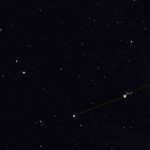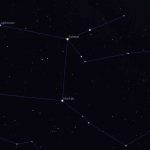| Meaning: | The Winged Horse | Print out the star map from Free Star Charts
Things to look for: Messier objects: Note: [x.x] indicates visual magnitude |
|
| Pronunciation: | peg’ ah sus | ||
| Associated Asterisms: | The Large Dipper, the Great Square | ||
| % of the sky: | 2.72% | ||
| Visible Stars: | 57 stars brighter than magnitude 5.5 |

Pegasus is a big object in Autumn skies occupying the South. It contains the asterism of the Great Square although the top left corner of the square, Alpharatz is actually part of next door Andromeda; α Andromedae. For a long time the star was shared between the constellations but in 1928 it was officially assigned just to Andromeda.
To find the constellation, traverse from Ursa Major (specifically Phecda), through Polaris, the North Star, to Caph in Cassiopeia (rightmost star in W) and then the same distance again (Polaris to Caph) to arrive at Alpharatz and the left side of the Great Square.
At first sight, the centre of the square looks quite sparse in terms of stars but depending on your location, once your eye dark adaptation is at its best, you may be able to count between 30 and 50 stars inside the asterism.


The constellation is named the Winged Horse although the mythology only draws the front end of the horse in the sky and is usually viewed upside down from the northern hemisphere. The legs and feet emanating from β Peg (Scheat) going left to upward right. The neck and head linked to Markab (α Peg) going left to lower right. The brightest star is Enif and is part of the head of the horse, its nostrils. This nose is the brightest star in the constellation.
Pegasus is light on deep sky object but does contain the globular cluster M15 and the first in the NGC series of objects, NGC 1. To find M15, imagine the head of Pegasus with the dimmer star at the forehead and Enif at the nostrils. Just follow this line further by about two thirds and you’ll find the globular cluster.

